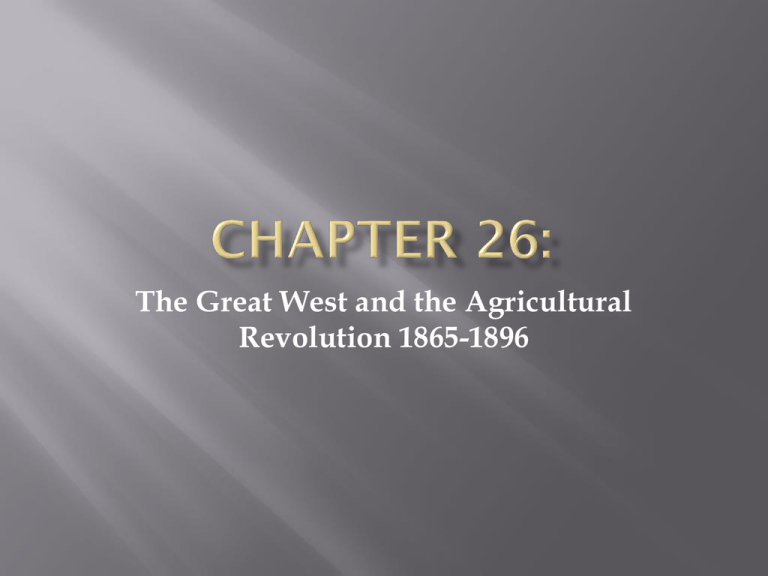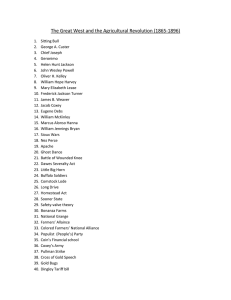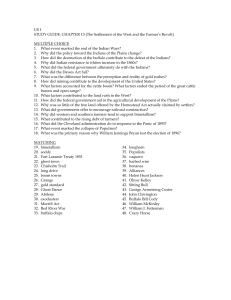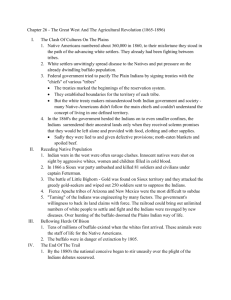Chapter 26 - Cloudfront.net
advertisement

The Great West and the Agricultural Revolution 1865-1896 Indians numbered 360,000 in 1860 Whites made problems between the Indians worse, disease, killed buffalo, took their lands etc. The reservation system started in 1851 with the Fort Laramie Treaty It was extremely hard to govern Indians, most didn’t recognize any authority outside of their family unless they agreed with it US fought Indians for decades after the Civil War 1/5th of cavalry in the West were Buffalo Soldiers Sand Creek Massacre 1864 Colonel Chivington 400+ Indians were murdered 1866 Sioux stopped work and use of the Bozeman Trail— Fetterman’s Massacre 81 US soldiers were killed 1868 Treaty of Fort Laramie US abandoned Bozeman Trail 1874 gold was discovered in Black Hills led to a gold rush and Sioux went to war to protect their home, were led by Sitting Bull and Crazy Horse Custer and 7th Cavalry were sent in to stop the Sioux 264 men attacked 2500, Custer and his entire command were killed 1877 Nez Perce under Chief Joseph surrendered and were exiled to Kansas not Idaho like they were promised Apache led by Geronimo went South to Mexico and were eventually exiled to Florida What allowed the taming of the Indians? RR brought soldiers, cattle, and settlers Disease, alcohol, buffalo exterminated Millions of bison roamed the plains and offered food, clothing and tools for thousands of Indians 15 million still lived in US after the Civil War Buffalo Bill Cody was a buffalo hunter for the RR’s across the plains Killed by the thousands for their hides, tongues, and amusement By 1885 only 1,000 left alive The awakening of America’s conscience—Helen Hunt Jackson A Century of Dishonor Split in how to deal with the Indians, assimilation or a forced containment Either way no room for their culture, gov’t outlawed Ghost Dance in 1884 Battle of Wounded Knee 1890 Killed 200 Indians and 29 soldiers Dawes Severalty Act 1887 Dissolved tribes as legal entities Wiped out tribal ownership of land, set up individual families with 160 acres, if Indians “behaved” they got title to land and American citizenship (1924) Land not distributed to Indians was sold to the RR and white settlers Carlisle Indian School in Pennsylvania Designed to teach Indian children how to be civilized away from their families School motto: Kill the Indian save the man Reasons for the Dawes Act Tried to civilize Indians, get them away from their tribes and make them rugged individualists Indian culture relied on the tribe holding land, when it was taken the culture would fall Lasted for the next 50 years until FDR RR and destruction of Indians were boons to mining In 1858 had Colorado discoveries, 59ers or Pikes Peakers Nevada—Comstock Lode, 340 $ million in silver Shifted from individual or small groups to large corporations Miners helped settle the West, mines acted like magnets to attract settlers The ore helped finance the Civil War Wild cattle on the southern plains helped spark the meat packing industry Long drives—cowboys drove herds hundreds of miles to the railheads to be shipped to the cities Barbwire ended the drive, settlers moved into the plains and fenced their property Over expansion, overgrazing, winter of 1886-87, all helped to kill the drive There was a major shift from long drives to fencing ranches to stop over production in order to keep prices higher Homestead Act of 1862 granted 160 acres for living on it for 5 years, making improvements to the land, and a 30$ fee Showed the shift in policy from the government making money off the land to just wanting it settled 500,000 families used it Full of fraud, large land corporations used fake names to accumulate thousands of acres Prairie had very thick sod that once broken revealed wonderful soil John Deere and steel plow 100th Meridian represented the area in the US that had enough rainfall to produce crops using conventional methods, once crossed it, West of it, wasn’t enough rain Pushed dry farming, very shallow cultivation that helped lead to the dust bowl New types of wheat and other crops in place of corn, and dams for irrigation projects made agriculture possible in the arid west The frontier was officially gone in 1890 Frederick Jackson Turner, Frontier Thesis Safety valve theory National parks to keep wild places, Yellowstone 1872, 1890 Yosemite and Sequoia American History to 1900 can be seen as a struggle to civilize the West, every aspect including the Civil War Farmers shifted from jacks of all trades to focusing on a single cash crop and all the problems that comes with it Became tied to the business world around them, banks, RR, manufacturing, etc. Inventions helped and hurt them, combine, mechanical reaper, steel plow, steam engine tractors, etc. Mechanization was too expensive and forced some farmers off the land America became the bread basket and butchers of the world Bonanza farms—giant farms run like corporations One crop leads to problems, price fluctuations hurt farmers Why do farmers love inflation? Fall in prices in the 1880’s led to deflation Look at it as to how much they have to pay back in farm goods, how many bushels of whatever did they borrow and how many do they have to pay back New machines increased the output, lowered prices more, took out loans to buy the machines which threw them in debt even farther Forced farmers into becoming tenant farmers by 1880 1/4th were tenant farmers Nature also hurt farmers: drought, severe winters, bugs, etc Doubly hurt by high protective tariffs Were at the mercy of the trusts: RR, barbwire, fertilizer, etc. Not easily organized like the trusts were too rugged individualist—nature of farmers Grange 1867 Oliver Kelley Started as a social movement ¾ of a million members by 1875 Goals included improving the farmers’ plight, escaping the hold of the trusts, coops, etc Also got involved in politics mostly on the local levels Influence faded by 1880s when courts overruled their laws, Wabash Greenback Labor Party Wanted inflation for farmers and other goals for labor 1 million votes for president and 14 congressmen in 1870’s Farmers Alliance late 1870’s Populist goals Break grip of trusts Excluded landless tenants and sharecroppers, blacks, and farm hands Led to the Populists Nationalizing RR, telephone, and telegraph Graduated income tax, direct election of senators, unlimited coinage of silver, etc. 1892 Populists won several congressional seats and had one million votes for their presidential candidate—Weaver Downfall of the Populists in the South was racism Depression of 1893 made the Populists believe them and labor could join together Jacob S. Coxey marched in protest of the plight of workers, was the leader of thousands, marched to Washington from Ohio only to have his protest end when he was arrested for walking on the grass Pullman Strike of 1894 Eugene Debs organized the American Railway Union and its 150,000 members against the Pullman Car Company who cut wages by 1/3 Federal troops broke up the strike 1st time injunctions were used, courts could find the strikers in contempt of court and arrest them without a trial Farmers and workers brought its issues to the election of 1896—ended the Gilded Age in American History Republicans put up William McKinley with a platform that straddled the fence on the money issue Democrats turned to William Jennings Bryan and his Cross of Gold speech with a platform for the unlimited coinage of silver, and Bryan pushed silver as the main issue of the election McKinley bought the election with the largest election fun in history (to date) 16 million dollars compared to 1 million for Bryan McKinley won 271-176 7.1 to 6.4 million popular votes Split the country North vs. South and West Showed the split between city and urban dwellers Last time a candidate tried to win using agrarian votes only Ushered in another era dominated by Republicans and big business, fewer voters from then on, weakened party organization McKinley gave business free reign and trusts got stronger Dingley Tariff Bill 1897 passed under Czar Reed 850 amendments before it passed 46.5% on most goods, much higher than the Democrats Wilson Gorman Tariff of 1894 1897-1st year in office the depression ended, not his fault but he got the credit for it of course this made the money issues moot Gold Standard Act of 1900 people could freely trade paper money for gold Gold discoveries in Klondike, Alaska, South Africa, and Australia brought gold onto the world market along with cyanide techniques to extract it more easily from the ore








